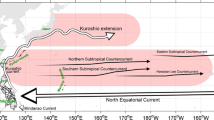Abstract
The processes underlying the development of the Kuroshio large meanders that occurred in 1986 and 1989 are investigated using a satellite SST data set and hydrographic data. In both processes visible on the satellite SST images, a round-shaped, lower SST region with a diameter of about 200 km is found to the east of the Kuroshio small “trigger” meander (Solomon, 1978) until the region became extinguished near theEnshu Nada. The lower SST region can be interpreted as an anti cyclonic eddy, mainly because of the existence of a warm water mass in the subsurface layer of this region. The warm water mass is characterized by a constant temperature of 18–19°C, the maximum thickness of which is about 400 m. The satellite images show that the eddy is closely related to the Kuroshio path transforming into a shape like the letter “S”. This means that the eddy plays an important role in the development of the Kuroshio large meander since this, too, tends to follow an “S”-shaped path. Added to this, the subsurface layer structure of the eddy is similar to that of the warm water mass offShikoku. This similarity, together with the eddy behavior visible on the satellite SST images, implies that the examined eddy corresponds to the warm water mass offShikoku. In other words, the warm water mass offShikoku can be advected near to theEnshu Nada when the Kuroshio large meander occurs.
Similar content being viewed by others
References
Akitomo, K., T. Awaji and N. Imasato (1991): Kuroshio path variation south of Japan 1. Barotropic inflow-outflow model.J. Geophys. Res.,96, 2459–2560.
Japan Maritime Safety Agency (1986):Kaiyo-Sokuhou (the oceanographic prompt report). No. 21.
Japan Maritime Safety Agency (1989):Kaiyo-Sokuhou (the oceanographic prompt report). No. 20, 21, 22, 23.
Japan Meteorological Agency (1986): Topics. In Ten-Day Marine Report, No. 1438 (in Japanese).
Japan Meteorological Agency (1989a): Monthly Report on Climate System, No. 89-12, 44 pp.
Japan Meteorological Agency (1989b): Topics. In Ten-Day Marine Report, No. 1549 (in Japanese).
Japan Meteorological Agency (1989c): Ten-Day Marine Report, No. 1551.
Kawabe, M. (1980): Sea level variation around the Nansei Islands and the large meander in the Kuroshio south of central Japan.J. Oceanogr. Soc. Japan,36, 227–235.
Kawabe, M. (1985): Sea level variations at theIzu Islands and typical stable paths of the Kuroshio.J. Oceanogr. Soc. Japan,41, 307–326.
Kawabe, M. (1988): On the study of large meander of the Kuroshio.Umi to Sora,64, 157–166 (in Japanese with English title, abstract, and figure legends).
Kawamura, H. and S. Saitoh (1995): Data set of the NOAA-HRPT received in Japan during 1981–1988.J. Japan Soc. Photogrammetry Remote Sens,34, 72–80 (in Japanese with English abstract).
Kawamura, H., K. Hanawa and Y. Toba (1984): On the characteristic structure of horizontal interleaving at the northern edge of the Kuroshio and the Kuroshio Extension. p. 333–346 In:Hydrographics of Japan and East China Seas, ed. by T. Ichiye, Elsevier Sci. Pub., Amsterdam.
Kawamura, H., S. Kizu, F. Sakaida and Y. Toba (1993): The NOAA-HRPT data receiving system in the Center for Atmospheric and Oceanic Studies in the Tohoku University.Tohoku Geophys. Journ. (Sci. Rep. Tohoku Univ., Ser. 5),34, 89–102.
Kimura, S. and T. Sugimoto (1993): Short-period fluctuation in meander of the Kuroshio’s path off Cape Shiono Misaki.J. Geophys. Res.,98, 2407–2418.
Kizu, S. and F. Sakaida (1996): A new set of MCSST equations for NOAA-9/AVHRR.J. Oceanogr. 52, 235–249.
Lamb, P. J. (1984): On the mixed-layer climatology of the north and tropical Atlantic.Tellus,36A, 292–305.
Minami, H., E. Kamihira and J. Nishizawa (1980): Some features of warm eddy south of Honshu in connection with Kuroshio Meanders. p. 157–170. In:The Kuroshio Meander and Cold Water Mass, Report by the Scientific Fund in 1979 from the Ministry of Education, Science, and Culture, Japan (in Japanese with English title and figure legends).
Nishiyama, K., S. Konaga and H. Ishizaki (1980): Warm water regions offShikoku associated with the Kuroshio meander.Meteorology and Geophysics,31, 43–52 (in Japanese with English title and abstract).
Nitani, H. (1977): On the process of the Kuroshio large meander generation, stagnation, and disappearance.Kaiyo-kagaku,9, 173–180 (in Japanese).
Sakaida, F. and H. Kawamura (1996): HIGHERS—the AVHRR based higher spatial resolution sea surface temperature data set intended for studying the ocean south of Japan.J. Oceanogr.,52, 441–455.
Sekine, Y. (1989): Topographic effect of marine ridge on the spin-down of a cyclonic eddy.J. Oceanogr. Soc. Japan,45, 190–203.
Sekine, Y. (1993a): On the path dynamics of the Kuroshio south of Japan.Umi no Kenkyu,2. 261–275 (in Japanese with English title, abstract, and figure legends).
Sekine, Y. (1993b): Topographic effect of a marine ridge on the spin-down of a cyclonic eddy with mean flow.J. Oceanogr.,49, 593–606.
Shoji, D. (1972): Time variation of the Kuroshio south of Japan. p. 217–234. In:Kuroshio—Its Physical Aspects, ed. by H. Stommel and K. Yoshida, Univ. of Tokyo Press, Tokyo.
Solomon, H. (1978): Occurrence of small “trigger” meanders in the Kuroshio off southern Kyushu.J. Oceanogr. Soc. Japan,34, 81–84.
Suga, T. and K. Hanawa (1990): The mixed-layer climatology in the northwestern part of the North Pacific subtropical gyre and the formation area of Subtropical Mode Water.J. Mar. Res.,48, 543–566.
Toda, T., N. Imasato and A. Takeda (1993): An analysis of the variation of the Kuroshio path using satellite thermal imagery.Umi no Kenkyu,2, 1–13 (in Japanese with English title, abstract, and figure legends).
Zhang, M. and Y. Sekine (1995a): A numerical experiment on the path dynamics of the Kuroshio south of Japan Part 1. Coastal topographic effect.La mer,33, 63–75.
Zhang, M. and Y. Sekine (1995b): A numerical experiment on the path dynamics of the Kuroshio south of Japan Part 2. Bottom topographic effect.La mer,33, 77–87.
Author information
Authors and Affiliations
Rights and permissions
About this article
Cite this article
Sakaida, F., Egusa, D. & Kawamura, H. The behavior and the role of the anti-cyclonic eddy in the Kuroshio large meander development. J Oceanogr 54, 101–114 (1998). https://doi.org/10.1007/BF02744384
Received:
Revised:
Accepted:
Issue Date:
DOI: https://doi.org/10.1007/BF02744384




